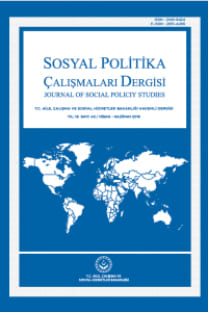Ebeveyn Yoluyla Munchausen Sendromu Olgularında Sosyal Hizmetin Rolü
Munchausen Sendromu, çocuk istismarının önemli bir formudur. Munchausen Sendromu, kişinin, bakım verdiği başka bir kişide fizik ya da psikolojik belirti ya da bulguları, amaçlı olarak ortaya çıkarması ya da o kişide bu tür belirti ya da bulgular varmış gibi davranmasıdır. Erken tanı ve multidisipliner profesyonel müdahale çocuğun korunması ve hayatta kalması açısından çok önemlidir. Hemen tüm yayınlarda istismarcıların tamamına yakınının biyolojik anneler olduğu, annelerin çoğunda da duygusal ve psikiyatrik sorunlar tespit edildiği bildirilmektedir. Bu çalışmanın amacı, Munchausen Sendromu olgularının psiko-sosyal yönlerinin, aile özelliklerinin ve çocuk üzerine etkilerinin değerlendirilmesi, tanı konulması, çocuğun korunması ve istismarcının tedavisi sürecinde sosyal hizmet disiplininin profesyonel rollerini ortaya koymaktır.
Anahtar Kelimeler:
Munchausen sendromu, çocuk istismarı, sosyal hizmet
The Role of Social Work in The Cases of Munchausen Syndrome by Proxy
Munchausen Syndrome by Proxy is an important form of child abuse. Munchausen Syndrome is a disorder in which a person deliberately causes injury or illness to another person most often his or her child, usually to gain attention or some other benefit. Early diagnosis and multidisciplinary professional intervention are very important in protecting the child and also for his or her survival. Almost all the publications indicate that the abusers are mostly biological mothers, most of whom suffer from psychological and emotional problems. The purpose of this article is to present the professional roles of social work in the process of diagnosis and treatment, and psychosocial assessment of Munchausen Syndrome by Proxy over children.
Keywords:
Munchausen by Proxy, child abuse, social work,
___
- Amerikan Psikiyatri Birliği (2000) DSM-IV-TR Tanı Öl- çütleri Başvuru Kitabı. Çeviren: Prof. Dr. Ertuğrul Köroğlu . Hekimler Yayın Birliği.
- Anderson L.E., Elisabeht A. W.,Howard J. D., Denise J. K (2002).”The Child-Centered Social Worker and the Sexually Abused Child: Pathway to Healing.” Social Work. Oct. 47(4).
- Ashman, K. Karen, Grafton H. Hull Jr. Understanding Generalist Practice. Second Edition. Nelson – Hall Publishers / Chicago. 1999.
- Davis, P. R. J. McClure, K. Rolfe, N. Chessman, S. Pe- arson, J.R. Sibert, R. Meadow (1998) ”Procedu- res, Placement, and Risks of Further Abuse After Munchausen Syndrome by Proxy, Non-acciden- tal Poisoning, and Non-accidental Suffocation”. Archives of Disease Childhood. 78 : 217-221.
- Guandolo, Y.L. (1985) “Munchausen Syndrome by Proxy: An Outpatient Challenge”. Pediatrics. 75: 525-530.
- Haddad, E., A. Lapeyraque, L. De Pontual, G. Landha- ler, N. Bocquet ve V. Baudouin (2002) Clinical Quiz. Pediatrique Nephrologie, 17, 217-219.
- Hotchkiss, S. (1997) “The Child as Fetish: Theoretical Considerations on The Etiology of Munchausen by Proxy Syndrome”. Clinical Social Work Jour- nal. 25 (3), 315-323.
- Jones J. G., Butler H.L., Hamilton B., Perdue J.D., Stern P., Woody R.C. (1986) Munchausen Syndrome by Proxy. Child Abuse and Neglect. 10. 33-40.
- Kaplan, H., B. Sadock (1998) Synopsis of Psychiatry. 8th Edition. Baltimore: Williams and Wilkins, pp. 654-657.
- Light M. J., Sheridan M. S. (1990)”Munchausen Synd- rome by Proxy and Apnea”. Clinical Pediatrics. 29. 162-169.
- Senner, Anne, Mary Jane Ott (1989) “Munchausen Syndrome by Proxy”. Issues in Comprehensive Pediatric Nursing. 12:5. 345-357.
- Scheper-Hughes, N. (2002) “Disease or Deception: Munc- hausen by Proxy as a Weapon of the Weak”. Anth- ropology and Medicine. 9 (2), 153-173.
- Proxy”.Child Abuse and Neglect. 27: 431-451.
- ISSN: 2148-9424
- Yayın Aralığı: Yılda 4 Sayı
- Başlangıç: 2012
- Yayıncı: Aile,Çalışma ve Sosyal Hizmetler Bakanlığı
Sayıdaki Diğer Makaleler
Çocuklarda Kitap Okuma Alışkanlığı’na Genel Bir Bakış
Yrd. Doç. Dr. Ebru Hasibe TANJU
Okul Öncesi Çocuklarda Uyum ve Davranış Problemleriyle Başa Çıkmada Ailenin Rolü
Yrd. Doç. Dr. Erdal HAMARTA, Arş. Gör. Önder BALTACI, Prof. Dr. Ömer ÜRE, Uzm. Psik. Dan. Elif DEMİRBAŞ
Yoksulluğun Kadınlaşması: Altındağ Örneği
Yrd. Doç. Dr. Gülsüm ÇAMUR DUYAN
Sosyal Kapitali Yapılandırmak: Sosyal İletişim Ağı ve Yardımseverlik-Gönüllülük
Huzurevinde Kalan Yaşlıların Hayata Bakış Açıları ve Gelecekle İlgili Beklentileri
Ebeveyn Yoluyla Munchausen Sendromu Olgularında Sosyal Hizmetin Rolü
